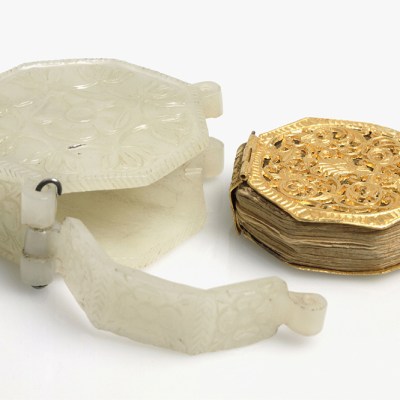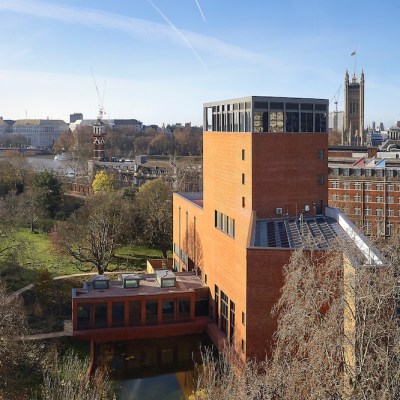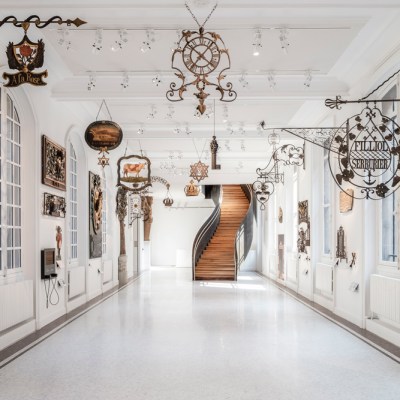From the February 2023 issue of Apollo. Preview and subscribe here.
The Richelieu site of the Bibliothèque nationale de France, located in the second arrondissement of Paris, has some claim to be the first public museum in the city. As early as 1741, doors were opened twice a week to allow visitors to inspect coins and medals from the Cabinet du Roi. Known today as the ‘Salon Louis XV’, the room was designed by the architect Ange-Jacques Gabriel and decorated by painters such as Charles-André van Loo, Natoire and Boucher. That this room can once again be admired by the public is one of the huge gains from 12 years of renovation. An institution that was long submerged in scaffolding, and little known beyond students and scholars, is now determined to open itself once again to the city, proving that it is far more than a repository of books, but also houses manuscripts, photographs, prints, paintings, coins, antiquities and scientific instruments. A child of the Enlightenment, the newly opened museum upstairs in the Bibliothèque is encyclopaedic in ambition, and the bold interventions into the fabric of the building by architects Bruno Gaudin and Virginie Brégal seek to promote ‘transversal’ links between different departments, readers and cultures.
The reopened Musée Carnavalet – half an hour’s walk away on the rue de Sevigné in the third arrondissement – demonstrates how a well-chosen staircase can open up a space and transform a collection. Gaudin and Brégal’s spiral version in elegant aluminium and steel is no exception, beckoning the visitor, who is now able to enter from a garden on the rue Vivienne, upwards to the suite of rooms on the first floor. Before ascending, there is the option of visiting the magnificent Salle Ovale, whose transformation from academic to public use typifies the new ethos of accessibility. Conceived by Jean-Louis Pascal in the 1890s, the splendours of the Salle Ovale – especially its glass roof – were largely forgotten after the decision in 1916 to make it a reference library, specialising in scholarly periodicals. Since September, however, anyone can come in off the street to browse the 20,000 works on the shelves, including the largest public collection of bandes dessinées in France, or learn more about the collections through some informative screens and playful animations.
The royal library was initially installed here in 1721–22. Right from the beginning, the first keeper, Abbé Bignon, noted that the space was insufficient to keep up with the pace of acquisitions, and over the three centuries of
its existence the Bibliothèque has benefited from some exceptional donations. Some of these donors are commemorated in the rooms of the museum upstairs. Visitors pass through the Salle de Luynes, which pays homage to Honoré d’Albert, duc de Luynes, a noted patron of Ingres and an expert on Greek vases, who gave nearly a thousand objects to the Bibliothèque nationale in 1862; the medals room is named for Abbé Barthélemy, who had the impossible job of acting as curator during the Revolution, while a glass door in the Rotonde affords a glimpse of the theatrical collections assembled by Auguste Rondel. The Rotonde has some works permanently on display, such as Jules Masson’s seductive portrait of Sarah Bernhardt, and currently hosts as well some enchanting costumes and maquettes on loan from the Comédie française.
But in a galaxy of collectors one name reigns supreme at Richelieu: that of Cardinal Richelieu’s political acolyte, Cardinal Mazarin. The renovation of the building has allowed the spaces that Mazarin commissioned in the 1640s to show off the cream of his collections to be used once again for the display of works of art. The Galerie Mazarin is one of the only surviving baroque galleries in France, and the mythological frescoes by Giovanni Francesco Romanelli have been returned to dazzling colour. The restorations have also uncovered some of the pagan deities whose flesh the cardinal’s prudish heir, the duc de Mazarin, ordered to be covered with painted veils in the 1660s: four of these veils have been retained, although the ceiling has otherwise returned to its original appearance.
The nine museum rooms are filled with objects carefully chosen by curators from each department; to single out highlights is invidious, since most exhibits are exceptional. Some of the royal artefacts have been exhibited since the mid 19th century, such as the seventh-century throne of Dagobert, or the chess pieces supposedly belonging to Charlemagne (which came via Abbé Suger from the abbey of Saint-Denis). Others have never been seen before, such as the silver-gilt manuscript bindings made for the treasury of the Sainte-Chapelle. Unsurprisingly, it is a feast for bibliophiles: the oldest known copy of Rabelais’s Pantagruel is joined by a manuscript copy of Les Misérables (bequeathed by Hugo to the Bibliothèque nationale in a codicil to his will) and one of Simone de Beauvoir’s Le Deuxième Sexe. Part of the autograph score of Mozart’s Don Giovanni makes a fitting accompaniment to a temporary exhibition about Molière and his fictions. The antique medals and silver are stupendous, especially the so-called Berthouville treasure, unearthed in 1830 in Normandy, at the site of a Gallo-Roman temple dedicated to Mercury.
The programme of renovations have allowed the Bibliothèque nationale to show off not only the diversity, but also the continuities within its collections. The rooftop glass walkway affords an amazing view over the Cour d’honneur, revealing the underlying coherence of a building that has passed through many phases. Gaudin has spoken of his desire to highlight the contribution of his predecessors and the renovations impart a sense of unity and flow to what used to feel a confusing amalgam. Now all the spaces in this seat of learning can hold their own alongside Labrouste’s pillared reading room. Along with the reopening in 2010 of the Archives nationales at the Hôtel de Soubise, this is a wonderful opportunity to rediscover the richness of French state collections in surroundings far more serene than the crush of tourists around the vitrines in the Galerie d’Apollon at the Louvre. In May 2023 the Richelieu will be celebrating its unrivalled collection of Degas sketchbooks with a show on his works in black and white: it promises to be unmissable.
From the February 2023 issue of Apollo. Preview and subscribe here.



